
Mass Extinction Events

Time periods in the history of life on earth during which exceptionally large numbers of species go extinct are called mass extinctions. Many species vanished in six cataclysmic mass extinctions. Today, 99.9 percent of all species that have existed on earth are extinct.
The very first mass extinction, The Great Oxidation Event, occurred about 2.4 billion years ago. For some reason, it is ignored by most people who do research on extinctions. Fast forwarding about 2 billion years most of the theoretical work is focused on the last 450 million years as shown in the chart to the left. From that time until the present there have been 5 mass extinctions. We shall cover what is known about the Great Oxidation Event and other ice ages, then press on to the 5 more recent events. Top
The Great Oxygenation Event And The First Ice Age
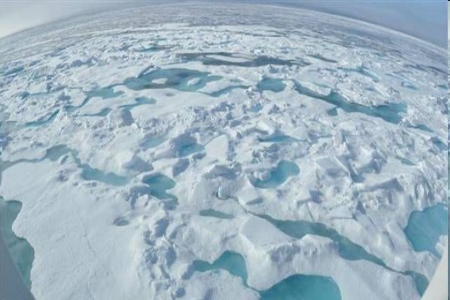
About 2.4 billion years ago (bya), a rise of oxygen in the atmosphere known as the Great Oxygenation Event (GOE), cooled the atmosphere and caused the first ice age. The earth was very different then. There were no leafy plants, no animals, no fish, no insects. There may have been some bacterial life on land, but it was the oceans that teemed with it. Most of the bacteria thriving on earth were anaerobic, (oxygen intolerant organisms) literally metabolizing their food without oxygen.
The first ice age is believed to have occurred about 100 million years later (2.3 bya) and is known as the Huronian Ice Age. The catalyst for the first ice age was believed to be a change in the atmosphere's composition. Previously, the earth’s atmosphere was thought to be composed mainly of methane, a strong greenhouse gas which kept the atmosphere and the surface quite warm.
Cyanobacteria (see the Early Life> page), which live in freshwater as well as the oceans, are thought to have appeared about 1.5 billion years before the GOE. See the modern cyanobacteria, below magnified 2400 times, a distant relative to the ancestor that changed the planet. Cyanobacteria produce oxygen by photosynthesis, i.e. inhaling carbon dioxide and exhaling oxygen. Before the GOE, most of the oxygen they produced was chemically captured by the water, and on land by dissolved iron or organic matter.
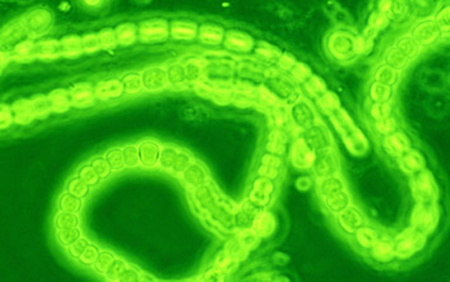
The GOE was the point when the oxygen sinks became saturated and could not contain any more of the oxygen that was produced by the cyanobacteria, so the excess free oxygen started to accumulate in the atmosphere. But as oxygen abundance increased, it combined with the methane to create carbon dioxide and water. Methane is a far more efficient greenhouse gas than carbon dioxide. Methane was keeping the planet warm then as the sun was about 25% to 30% cooler. As atmospheric methane levels dropped, the earth cooled. The entire planet gradually cooled and sheets of ice began to spread across the surface of the planet triggering the Huronian glaciation. The Huronian Ice Age lasted about 200 million years until about 2.1 billion years ago.
Free oxygen is toxic to anaerobic (oxygen intolerant) organisms which populated the atmosphere at the time. The rising concentrations wiped out almost all of the earth's anaerobic inhabitants. Cyanobacteria were therefore responsible for one of the most significant extinction events in the earth's history. Most likely, it was also the longest ice age in the earth's history. Oxygenation destroyed almost all anaerobic life and even much of the Cyanobacteria itself. The whole world was covered in ice and snow (snowball earth) driving most bacteria type organisms into extinction, except those that could survive in the deep cold waters underneath the ice pack.
However, very recent data suggests that the earth’s atmosphere was already somewhat oxygenated about 3 billion years ago. “Instead of a simple two-stage early earth model with a non-oxygen atmosphere prior to 2.3 billion years ago and oxygen conditions ever after, we had at least a 600 million years long transition phase,” says Michael Bau, a geoscience professor at Jacobs University in Germany. The Huronian Ice Age is still believed to have occurred about 2.3 million years ago, it was just that the oxygenation increase was gradual, not sudden. Top
Snowball Earth

In the early 1990s geologists discovered evidence of glaciers in the tropics. Since then, a growing body of evidence has shown that a global deep freeze began somewhere around 715 million years ago, and lasted about 80 million years. Exactly how far the ice extended is still a matter of some debate. A number of questions exist, including whether the earth was a full snowball, or a "slushball" with a thin equatorial band of open (or seasonally open) water.
Some argue that the entire earth was encased in ice, with just a few small pockets of open water where hot springs bubbled up or where volcanos pumped warm gas and lava into the atmosphere. Others believe that a belt of open water remained around the earth's equator.
Regardless of how far the ice stretched, most scientists agree that the snowball formed suddenly. It was "probably" caused by rapid weathering of earth's continents, which sucked carbon dioxide (the warming greenhouse gas) out of the atmosphere which caused temperatures to plummet.
There were two distinct periods of extreme glaciation, with a 20 million year warm period in between them. The average temperature was a frigid -20°C, equivalent to modern day Antarctica. Most life was wiped out. The marine creatures that did survive huddled in small pockets of open water where hot springs continued to bubble up. Finally, about 635 million years ago, earth's volcanoes topped up the atmospheric with enough new carbon dioxide to bring the earth out of its frozen state. Top
The Ordovician Extinction
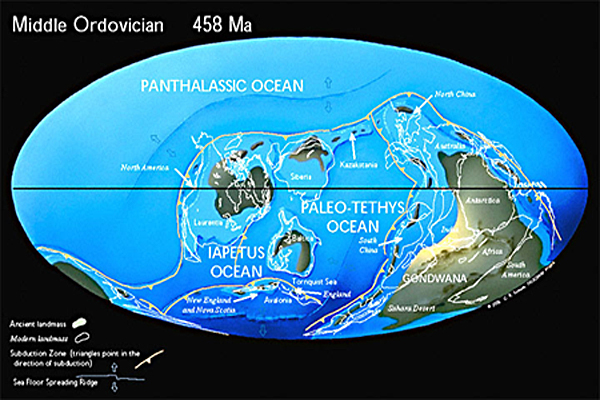
The Ordovician Period of the Paleozoic era covers the time between 490 and 434 million years ago. It follows the Cambrian period and is followed by the Silurian period. An important evolutionary change in the Ordovician Period was the evolution of deep-water organisms. Many forms of life moved out of their early shallow water environments to colonize deeper water and in doing so created new habitats and niches that supported new groups of organisms. The Ordovician environment was generally made up of shallow, warm seas, making it favorable for marine life with sea levels relatively high throughout most of this period.
Life continued to flourish during the Ordovician as it did in the Cambrian. Invertebrates, namely mollusks and arthropods, dominated the oceans. Fish, the world's first true vertebrates, continued to evolve, and those with jaws may have first appeared late in the period. The Ordovician Period created abundant ocean oriented fossils, but life had yet to diversify on land.
During the Ordovician, the southern continents formed a single "supercontinent" called Gondwana. See the illustration above, Gondwana is in the lower right hand corner. At the start of the period Gondwana was located at the equator but as the period progressed, it drifted towards the South Pole.

At the end of the Ordovician Period, the world entered an intense ice age brought about by the new location of Gondwana over the South Pole. The formation of large ice sheets meant sea levels fell dramatically by as much as 70 to 100 meters. This particularly affected the corals and other organisms that were living in shallow seas which were drained of water. Global cooling also spelled disaster for warm-water species that had nowhere to migrate to.
26% of all marine families and about 80% of all species went extinct. Although no major groups were completely lost, many sea creatures suffered substantial losses. Over 90% of trilobites, the dominant species during this period, were lost. Also heavily damaged were the nautiloids (cousins of today's squid), which were the top marine predators at the time.
Then, after about 1 million years, the glacial conditions ended rapidly. Sea levels rose and water low in oxygen blanketed the shallow marine habitats delivering a second blow to the marine life that had managed to survive. This extinction marked the end of the Ordovician Period and the beginning of the Silurian Period. Top
The Late Devonian Extinction

The Devonian Period Era extended from about 410 million years ago (Ma) to about 354 Ma. It is named after Devon, England, where rocks from this period were first studied. When the Devonian period dawned the planet was changing its appearance. The great supercontinent of Gondwana was headed steadily northward away from the South Pole, and a second supercontinent began to form that straddled the Equator. Known as Laurussia, it was created by the coming together of parts of North America, northern Europe, Russia, and Greenland.
The Devonian period experienced the first significant terrestrial life. Plants began to spread across dry land forming extensive forests which covered the continents. By the middle of the Devonian, several groups of plants had evolved leaves and true roots, and by the end of the period the first seed-bearing plants appeared. With large land-animals not yet present, large forests could grow and shape the landscape.
Fish reached substantial diversity during this time, leading the Devonian to often be dubbed the "Age of Fish". It is famous for the thousands of species of fish that developed. We know this because of fish fossils found in Devonian rocks. A major development was fish with jaws, gills and paired fins. Sea levels were high worldwide, and much of the land lay under shallow seas, where tropical reef organisms lived.
The Late Devonian Extinction took place about 360 million years ago and its cause is still uncertain. Many paleontologists believe that there were several extinctions over a short period rather than just one massive one. Evidence supporting the Devonian mass extinction suggests that warm water marine species were the most severely affected. Although up to 70 percent of marine species died, terrestrial plants and animals were largely unaffected. This has lead many paleontologists to believe that several episodes of global cooling may have lead to the Devonian Extinction. Some scientists have suggested that this extinction may have been triggered by glaciation events on Gondwana. This theory is supported by glacial deposits of the Devoian age found in northern Brazil. However, the exact cause is not known so this theory should be viewed as somewhat speculative. Top
Pangaea And The Permian Extinction
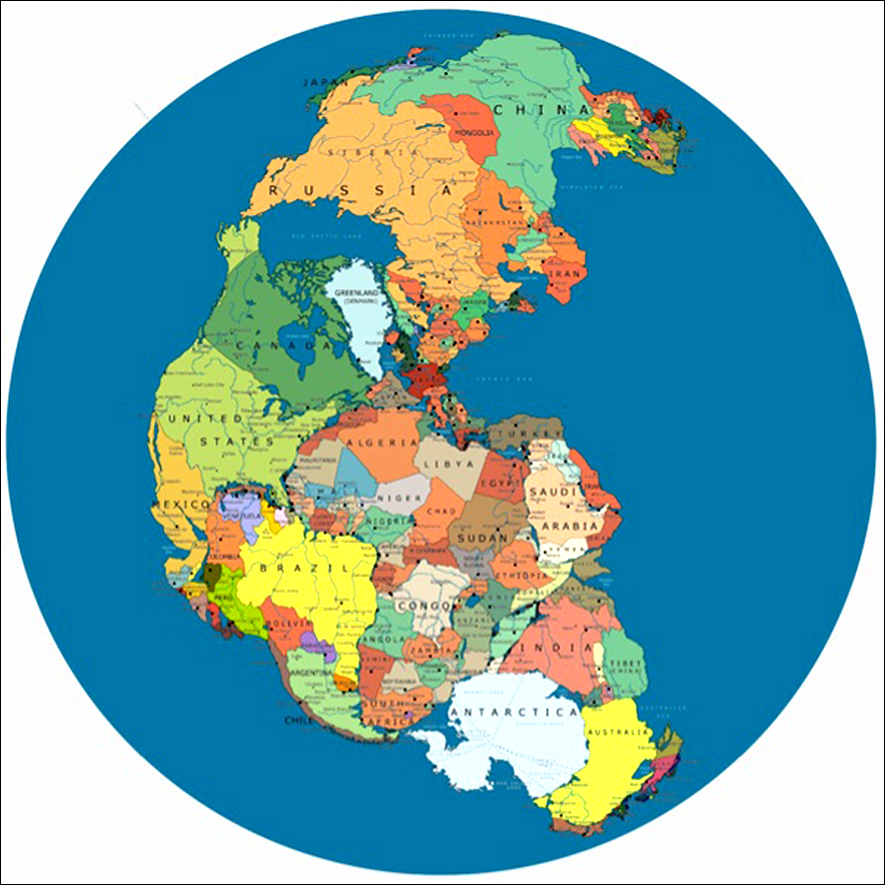
The Permian Period extended from about 300 million years ago (Ma) to about 250 Ma. The world at that time had converged into a single "supercontinent" known as Pangaea. Pangaea was surrounded by a global ocean called the Panthalassa. Pangaea presented severe extremes of climate and environment due to its vast size. The south was cold and arid, with much of the region frozen under ice caps. Northern areas suffered from intense heat and great seasonal fluctuations between wet and dry conditions. The lush swamp forests of the previous Carboniferous Period were gradually replaced by conifers, seed ferns, and other drought resistant plants.
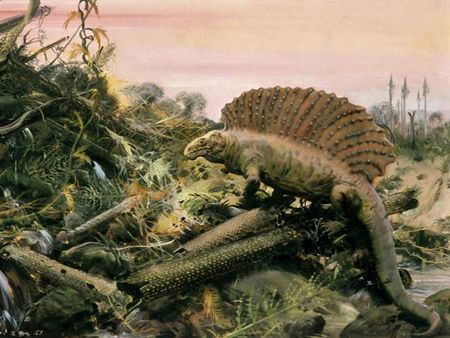
Early reptiles capitalized on the new environment. Shielded by their thicker, moisture-retaining skins, they moved in where amphibians had previously held sway. Over time, they became ideally suited to the desert-type habitats in which they thrive today. Being cold-blooded, reptiles had to find ways to deal with big daily variations in temperature, from below freezing at night to over 100 degrees Fahrenheit during the day. Some of the primitive reptiles, which measured up to ten feet long, had sail-like structures on their backs that are believed to have acted as heat exchangers, catching the sun in the early morning to help warm themselves. See the dimetrodon illustrated at the left.
Later, other mammal-like reptiles found an internal solution to keeping warm. Scientists believe they eventually became warm-blooded, conserving heat generated through the breakdown of food. These more active reptiles, which could survive the harsh interior regions of Pangaea, became the dominant land animals of the late Permian. The Permian seas came to be dominated by bony fishes also with fan-shaped fins and thick, heavy scales.
The Permian Extinction happened about 251 million years ago and was earth's worst mass extinction. 95 percent of all species, 84 percent of marine species, and an estimated 70 percent of land species such as plants, insects and vertebrate animals, were doomed during this catastrophe. Direct extinction evidence for this period has not been found but many scientists believe a comet or asteroid impact led to the extinction. Others think that volcanic eruptions, coating huge stretches of land with lava from the Siberian Traps (close to the Russian City of Tura) including the related loss of oxygen in the seas, were the cause of this mass extinction. Still other scientists suspect that the impact of a comet or asteroid triggered the volcanism. No one is sure of the exact cause at this time. Top
The Triassic-Jurassic Extinction

The Triassic period was named in 1834 by the German geologist Friedrich Von Alberti. It got its name because this period of geologic time is represented by three different types of rock formations found in Germany.
The Triassic Period occurred from approximately 250 million to 205 million years ago. At the beginning of the Triassic, most of today's continents were still located in the supercontinent Pangaea (see the Pangaea map above). The climate was generally very dry over most of Pangaea with hot summers and cool winters. It was considerably warmer than today with no polar ice caps.
Fossils found in Triassic rocks suggest that this was a period of transition, in which older forms of plants and animals died out and new ones began to appear. A major extinction had occurred at the end of the Permian period. About 95 percent of all species had become extinct. The oceans in particular had been massively depopulated by the Permian Extinction.
Fossil fish from the Triassic Period are very uniform, which indicates that very few fish families survived the Permian Extinction. However, this was the period when life outside of the oceans began to diversify. Amphibians, reptiles, and dinosaurs began to dominate the swamps and land areas. See the artist conception of early dinosaurs above. Another big first was that " true mammals", small, shrew-like creatures, also appeared during the Triassic.
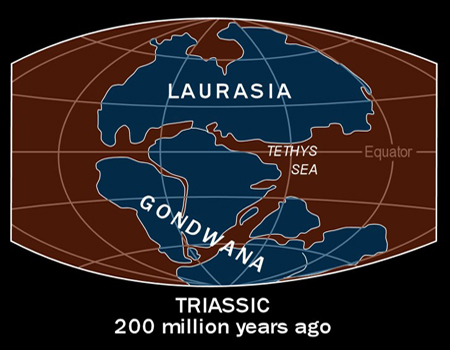
Late in the Triassic, the sea floor started spreading in the Tethys Sea, (which separated current Russia and Europe from North America) and this led to a split between the northern and southern portions of Pangaea. See the map of about 200 years ago to the left. Pangaea separated into two continents, Laurasia and Gondwana, which fully formed in the following Jurassic Period.
The Triassic-Jurassic (T-J) Extinction occurred about 210 million years ago accompanied by huge volcanic eruptions. 35% of all animal families died out, including virtually all amphibians and most marine reptiles, except for the new small mammals. Most of the early, primitive dinosaurs also went extinct, but other more adaptive dinosaurs evolved in the following Jurassic Period.
The leading extinction theory suggests massive volcanic eruptions were triggered when the supercontinent of Pangea ripped apart into separate continents. Along with lava flows, the volcanic eruptions released massive amounts of the greenhouse gas, carbon dioxide, into the atmosphere creating havoc in the ecosystem.
A study, published in April 2016 in Nature Communications, charts the sharp escalation of the element mercury in samples of rock preserved from the Triassic-Jurassic period. It isn’t the ordinary mercury one finds on the surface of the planet. Isotopic data indicates this type of mercury can be directly traced to the volcanic eruptions. This type of mercury was found in the T-J rock samples and it matched a wave of animal extinctions on the earth’s surface and in the seas. The mass extinction "peaks" just as this particular level of mercury does. Biodiversity begins to return once this particular mercury level recedes, about 700,000 years after the event began. (This makes the T-J event the most relevant mass extinction to study when trying to predict what might happen considering today's rising CO2 levels.)
The T-J extinction allowed the dinosaurs to expand into many niches that were unoccupied. Dinosaurs would become increasingly abundant and dominant. They remained that way for the next 150 million years. Top
The Cretaceous Period

The name Cretaceous is derived from creta, Latin for chalk, and was first proposed by Omalius d’Halloy in 1822. D’Halloy had been commissioned to make a geologic map of France, and part of his task was to decide upon the geologic units to be represented by it. One of his units, the Terrain Crétacé, included chalks and underlying sands. The Cretaceous Period lasted about 80 million years from 145 million to 65 million years ago.
Chalk is a soft, fine-grained type of limestone composed predominantly of the armour-like plates of tiny floating algae that flourished during the Late Cretaceous. Most Cretaceous rocks are not chalks, but most chalks were deposited during the Cretaceous. Many of these rocks provide clear details of the period because they have not been deformed or eroded and are relatively close to the surface. An example is the White Cliffs of Dover between France and England. Continents were moving during the Cretaceous, busy remodeling life on earth. At the start of the period, dinosaurs ruled the remnants of the supercontinent Pangaea. Rodents scurried around the roots of forests of ferns and conifers.
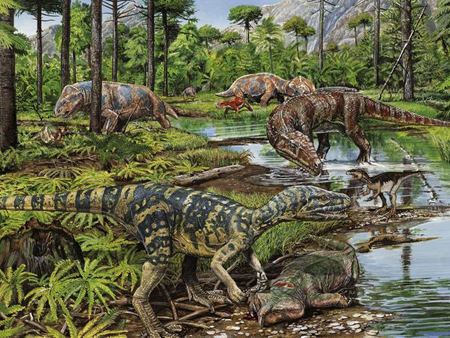
Oceans filled huge gaps between isolated continents almost as they are today. See the map to the left above. In general, world oceans were about 300 to 600 feet higher in the Early Cretaceous and roughly 600 to 800 feet higher in the Late Cretaceous than they are today. Sea levels were higher during the Cretaceous than at any other time in earth's history. The high Cretaceous sea levels were thought to be the result of water in the ocean basins being displaced by the growth of mid-ocean ridges. Approximately one-third of today's landmass was underwater back then. For example, note on the map that the Rocky Mountains were not attached to the central part of the U.S., so, many mid-west states were under water. Also, most of Arabia as well as half of India (next to South Africa) were under water.
The Cretaceous picked up where the Jurassic left off: Gigantic sauropods (huge four legged monsters, see the picture to the left below) led parades of dinosaurs through the forests, over plains, and along the coasts. Long-necked and toothy marine reptiles terrorized fish and mollusks in the seas. Hairy feathered birds filled the skies. In general, the climate of the Cretaceous Period was much warmer than at present, perhaps the warmest of any time in the earth's history. The climate was also more equable in that the temperature differences between the poles and the Equator were about one-half that of the present difference.

Though dinosaurs ruled throughout the Cretaceous, the dominant groups shifted and many new types evolved. Sauropods dominated the southern continents but were rare in the north. Herd dwelling Iguanodon (four legged beasts with short stubby tails) spread everywhere but Antarctica. Toward the close of the Cretaceous, vast herds of horned beasts such as Triceratops (medium four legged beasts with two horns on heir heads) munched low-lying plants on the northern continents. The carnivore Tyrannosaurus rex (T-rex, see picture at the left below) dominated the late Cretaceous in the north while monstrous meat-eaters like Spinosaurus (big two legged dinosaurs, similar to T-rex only larger) that had a huge sail-like fin on their backs, thrived in the south. Dinosaurs roamed Antarctica, even with its long winter nights.
Other creatures, such as frogs, salamanders, turtles, crocodiles, and snakes, proliferated on the expanded coasts. Shrew-like mammals scurried about the forests. The huge pterosaur flying reptile soared overhead, though the group as a whole faced ever stiffening competition from fast diversifying birds. Ancestors to modern pelicans and sandpipers all showed up in the Cretaceous. However, it was the rapid dispersal of flowering plants that stole the show in the Cretaceous. They spread with the help of insects from bees and wasps to ants and beetles. Magnolia, ficus, and sassafras quickly outnumbered ferns, conifers, gingkoes, and cycads. Top
The Cretaceous Extinction

The Cretaceous Extinction occurred about 65 million years ago. The event was initially known as the Cretaceous-Tertiary (K-T) event, but the International Commission on Stratigraphy, which sets standards for geologic time, now discourages the use of the term Tertiary. (However, it is still pretty widely used.) The "K" in K-T is from the German word for Cretaceous, i.e. Kreide. Wikipedia now calls this The Cretaceous Paleogene (K–Pg) extinction event.
Nearly all large vertebrates and many tropical invertebrates became extinct in what was clearly a geological, climatic and biological event with worldwide consequences. Most of the rich life, including all dinosaurs, pterosaurs, and ammonites (spiral-like shell fish) perished. No "tetrapods" (four-footed creatures) weighing more than 25 kilograms (55 pounds) survived. Of the planktonic marine flora and fauna, only about 13 percent of the species survived.
The marine organisms that lived on the bottom of the ocean largely died out as well. Corals were reduced to about one-fifth of their species. Overall, approximately 75 percent of all species disappeared, making this one of the largest mass extinctions in earth’s history. In fact, the land, seas, and skies would never be the same. Top
The Chicxulub Asteroid Theory
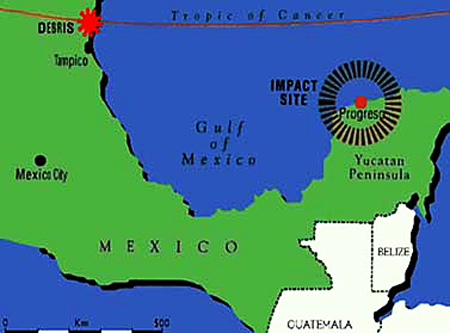
Since the early 1980s, attention has been focused on the Chicxulub (CHEEK-she-loob) Asteroid Theory formulated by American scientists Walter and Luis Alvarez (father and son). This theory states that the impact of an approximate 7 mile wide asteroid on the earth probably triggered the extinction event by ejecting a huge quantity of debris into the atmosphere, enshrouding the earth in darkness for several years. See the impact site area in the map to the left. With a force of 100 trillion tons of TNT (two million times stronger than the most powerful man-made bomb), it crashed into our planet and created devastating consequences for both the dinosaurs and all other life.
There is much evidence in the rock record that supports this hypothesis. A huge crater 180 km (112 miles) in diameter dating to the late Cretaceous period lies buried beneath sediments of the Yucatán Peninsula near Chicxulub, Mexico. In addition, fractured sand grains characteristic of meteorite impacts and the rare-earth element iridium (which is common only deep within earth’s mantle and in extraterrestrial rocks) have been found in deposits associated with the extinction. Only a collision with a large extra-terrestrial body could account for the levels of iridium present in the rock and the worldwide distribution of it.
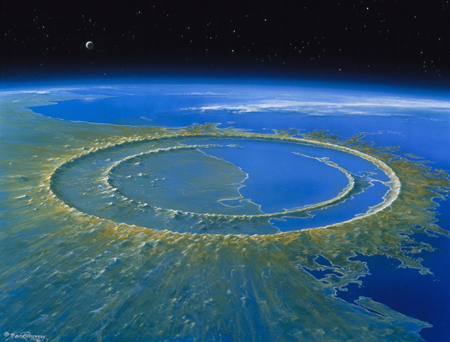
New analyses of NASA gravity measurements have turned up evidence that the crater is a multi-ring basin with a fourth outer ring about 300 kilometers (186 miles) in diameter. See an artist's impression to the left of what the crater probably looked like shortly after the impact. At this diameter, the Chixulub Basin represents one of the largest collisions in the inner solar system since the "heavy bombardment" period ended almost four billion years earlier. The only known comparable post-bombardment basin is the 280 kilometer (173 miles) diameter Mead Basin on Venus.
Climate scientists have reconstructed how tiny droplets of "sulfuric acid" formed high up in the air after the impact of the asteroid which blocked sunlight for several years and had a profound influence on life. Plants died and death cascaded through out the food chain. Early theories focused on the effect of shorter-lived dust ejected by the impact. However, recent computer simulations show that the droplets of sulfuric acid resulted in a long-lasting cooling, which was the most likely event that led to the death of the dinosaurs. Estimates indicate that three times as much sulfur may have entered the air compared to what previous models assumed, implying that the ensuing period of cold weather may have been much colder than previously thought.
The key finding of the studies is that a larger amount of sulfur and a smaller amount of carbon dioxide were ejected than in previous studies. The result was that the earth became very cold. Global annual mean surface air temperatures dropped by at least 26 degrees Celsius (47 degrees Fahrenheit). Immediately after the asteroid's impact, the annual average temperature was "below freezing" for about three years. Even in the tropics, annual mean temperatures went from 27 degrees C to a mere 5 degrees. Also, the ice caps expanded considerably. The dinosaurs were used to living in a lush climate and the freezing cold was a deadly problem for them.
The long-term cooling caused by the sulfate aerosols was much more important for the mass extinction than the dust that stayed in the atmosphere for a relatively short time. It was also much more important than local events such as the extreme heat close to the impact, or wildfires, or tsunamis. The new results show the impact likely released approximately 325 billion tons of sulfur and 425 billion tons of carbon dioxide into the atmosphere. In contrast, the previous study that modeled the earth's climate after the collision had "assumed" 100 billion tons of sulfur and 1,400 billion tons of carbon dioxide. Scientists estimate it took the earth's climate about 30 years to recover.
An additional fatal mechanism was a vigorous mixing of the oceans caused by the surface cooling, severely disturbing marine ecosystems. Surface waters cooled down, thereby becoming denser and thus heavier. While these cooler water masses sank into the depths, warmer water from deeper ocean layers rose to the surface, carrying nutrients that likely led to massive blooms of algae. It is conceivable that these algae blooms produced toxic substances, further affecting life. In any case, marine ecosystems were severely altered, and this likely contributed to the extreme extinction of species in the oceans including the ammonites. Top
The Deccan Volcano Theory

Geologist Gerta Keller of Princeton University and her colleagues recently looked at the geological records in India, Mexico and Texas to pin down "exactly when" the Chixulub asteroid impact and the Deccan (DE-can) volcanism in India occurred in relation to the K-T extinction. See the Cretaceous period map above for the location of India then (an island located near south Africa).
The Deccan Traps (mountainous steps in India pictured at the left) began forming 66.25 million years ago at the end of the Cretaceous period. The series of eruptions lasted about 30,000 years. The original area covered by the lava flows is estimated to have been 600,000 square miles, half the size of modern India. The Deccan Traps region was reduced to its current size by erosion and plate tectonics. The present area of directly observable lava flows is about 200,000 square miles. Within the Deccan Traps, 95% of the lava is basalts (very dark gray, fine grained fiery rock resulting from volcanic magma activity). The Deccan Traps are famous for the fossils that have been found between the layers of lava.
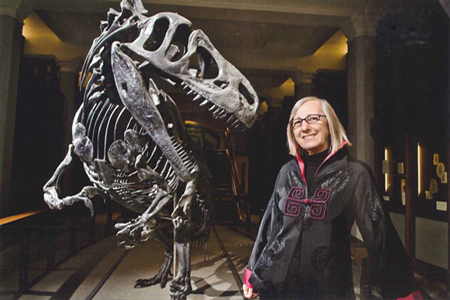
By carefully examining sediment layers in Mexico, the Keller team found that the Chixulub crater impact occurred about "100,000 years before the K-T boundary", with only a modest effect on nearby plant and animal life. "There is essentially no extinction associated with the impact," Greta Keller (pictured to the left) says. In contrast, the main thrust of the Deccan volcanism occurred "just before the K-T boundary". "I’m not saying the impact didn't’t have any effect. But based on the data we have, the effect was not long lasting and caused no extinctions in the oceans. Within a few hundred years, life went back to normal", says Keller.
In addition, when comparing the amounts of sulfur dioxide emitted by the Chixulub crater impact and the Deccan volcanism, they found that the volcanos spewed out significantly more sulfur dioxide. The Chicxulub crater put somewhere between 50 billion and 500 billion tons of sulfur dioxide into the air. The Deccan Traps spewed on the order of 10,000 billion tons into the atmosphere.
Based on the above data, Keller and her colleagues think that the Deccan volcanic traps are a much, much more likely culprit for the Cretaceous extinction than the asteroid impact. "I’m happy to say that today there is strong evidence that virtually every mass extinction - all five major ones - are associated with volcanic eruptions. And that should tell us that volcanism is a very important part in the evolution of life", Keller says. Her work was supported by the US National Science Foundation. Top
Extinctions Summary
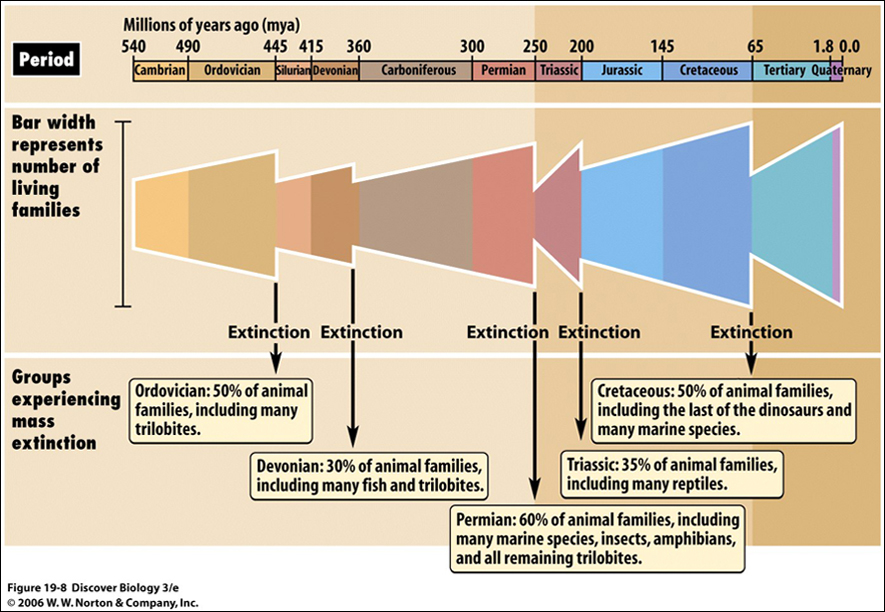
Above is a nice summary of the last five major extinctions. The percentages of mass families affected differs somewhat from our research, but that is to be expected when dealing with forecasts of what took place many, many millions of years ago.
Top